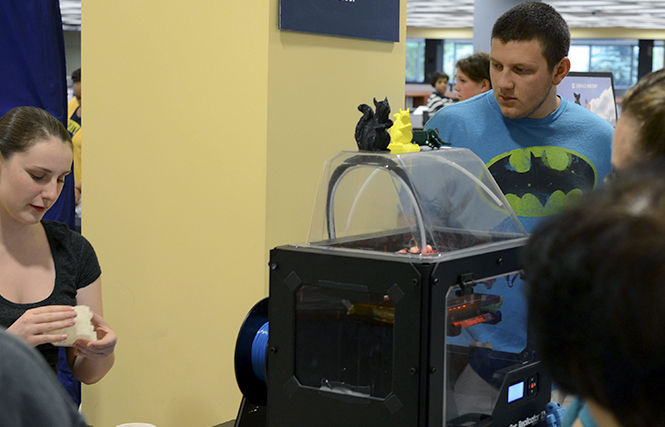Student Multimedia Studio scans more than paper
The Kent Stater Senior broadcast journalism major Lauren Blue, explains to students how the 3D printer in the multimedia studio works in the Kent State library.
November 2, 2014
Instead of paper objects, the Student Multimedia Studio has focused its latest 3-D scanning project on people.
The SMS originally started out on the third floor of the University Library in 1998, in a tiny room that had one computer and one tape deck. Within a year, SMS Manager Hilary Kennedy said the studio expanded to a bigger space with three computers.
And then it grew from there.
In 2003, the studio made its move to the first floor, where it is currently located past the Circulation Desk on the left-hand side. The studio includes a variety of software and equipment, from the entire Adobe Creative Suite 6 products to video edits suites, entirely for student use.
Kennedy said the resources used by most Kent State students in the SMS are the scanners.
“We have students come in all the time from physics classes where they have to scan in their entire lab workbooks and turn them in for a class, or international students will come in and have to scan in their passports,” Kennedy said. “That’s one of the most popular things, just coming in and being able to scan something.”
The SMS is home to two 3-D printers, which are the latest resources to be added to the studio. Kennedy said having the dueling printers has been really helpful, especially with the increase of student use.
The SMS has already worked on more than double the student projects compared to last fall, Kennedy said.
The latest project the studio has been working on in is 3-D scanning.
“We have a little connect device, like an Xbox Kinect with gesture-based controls, but we have the Windows Connect version of that,” Kennedy said. “We found free software, ReconstructMe, that allows you to use the Connect as the scanning tool, and we’ve just tested it with people so far.”
One of the 3-D scanning test runs was on James Bracken, the dean of the university library.
“I sat in a little chair that had a swivel, and I rotated slowly,” Bracken said. “It picked up and showed every bump, every wrinkle and it extended my hair. Only my upper torso was scanned, from my waist up as I rotated, so it shows my back and the back of my head. I looked like I could be a charm on a charm bracelet.”
The studio purchased the Connect last fall, Kennedy said, and tried to use the software that came with it but had trouble getting it to scan well.
“It’s not for an animate object,” Bracken said. “If you were scanning something that was inanimate, like a vase, it would produce a 3-D visual, which then you could print or use for a visualization.”
People were easy to start off scanning, and the studio hasn’t tested anything other than people, Kennedy said. It’s still a work in progress.
Along with the 3-D scanning and printing, there is also a 3-D pen.
“With the 3-D pen, it’s easy and allows you to create whatever you want with it. It’s free-hand and processes right when you finish so you can walk away with what you created,” Kendra Bates, an electronic media production major, said.
The 3-D pen requires filament, like the printer, and you press a button to begin crafting what you want. It’s similar to a hot glue gun, but with plastic.
Any Kent State student can use the 3-D pen in the SMS under supervision of the studio’s staff and prior to completing a training process.
The Student Multimedia Studio is a free resource that is open seven days a week during the school year.
Contact Olivia Young at [email protected].












